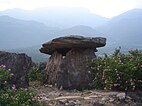Prehistoric era (until c. 3300 BCE)
Mesolithic rock art at the
Bhimbetka rock shelters,
Madhya Pradesh, showing a wild animal, perhaps a mythical one, attacking human hunters. Although the rock art has not been directly dated,
[28] it has been argued on circumstantial grounds that many paintings were completed by 8000 BCE,
[29] and some slightly earlier.
[31] Paleolithic
Hominin expansion from Africa is estimated to have reached the Indian subcontinent approximately two million years ago, and possibly as early as 2.2 million years before the present. This dating is based on the known presence of Homo erectus in Indonesia by 1.8 million years before the present and in East Asia by 1.36 million years before present, as well as the discovery of stone tools at Riwat in the Soan River valley of the Pabbi Hills region, Pakistan.[35] Although some older discoveries have been claimed, the suggested dates, based on the dating of fluvial sediments, have not been independently verified.
The oldest hominin fossil remains in the Indian subcontinent are those of Homo erectus or Homo heidelbergensis, from the Narmada Valley in central India, and are dated to approximately half a million years ago. Older fossil finds have been claimed, but are considered unreliable. Reviews of archaeological evidence have suggested that occupation of the Indian subcontinent by hominins was sporadic until approximately 700,000 years ago, and was geographically widespread by approximately 250,000 years before the present, from which point onward, archaeological evidence of proto-human presence is widely mentioned.
According to a historical demographer of South Asia, Tim Dyson:
Modern human beings—Homo sapiens—originated in Africa. Then, intermittently, sometime between 60,000 and 80,000 years ago, tiny groups of them began to enter the north-west of the Indian subcontinent. It seems likely that initially, they came by way of the coast. ... it is virtually certain that there were Homo sapiens in the subcontinent 55,000 years ago, even though the earliest fossils that have been found of them date to only about 30,000 years before the present.[37]
According to Michael D. Petraglia and Bridget Allchin:
Y-Chromosome and Mt-DNA data support the colonization of South Asia by modern humans originating in Africa. ... Coalescence dates for most non-European populations average to between 73–55 ka.
And according to historian of South Asia, Michael H. Fisher:
Scholars estimate that the first successful expansion of the Homo sapiens range beyond Africa and across the Arabian Peninsula occurred from as early as 80,000 years ago to as late as 40,000 years ago, although there may have been prior unsuccessful emigrations. Some of their descendants extended the human range ever further in each generation, spreading into each habitable land they encountered. One human channel was along the warm and productive coastal lands of the Persian Gulf and northern Indian Ocean. Eventually, various bands entered India between 75,000 years ago and 35,000 years ago.[39]
Archaeological evidence has been interpreted to suggest the presence of anatomically modern humans in the Indian subcontinent 78,000–74,000 years ago,[40] although this interpretation is disputed.[41][42] The occupation of South Asia by modern humans, over a long time, initially in varying forms of isolation as hunter-gatherers, has turned it into a highly diverse one, second only to Africa in human genetic diversity.[43]
According to Tim Dyson:
Genetic research has contributed to knowledge of the prehistory of the subcontinent's people in other respects. In particular, the level of genetic diversity in the region is extremely high. Indeed, only Africa's population is genetically more diverse. Related to this, there is strong evidence of ‘founder’ events in the subcontinent. By this is meant circumstances where a subgroup—such as a tribe—derives from a tiny number of ‘original’ individuals. Further, compared to most world regions, the subcontinent's people are relatively distinct in having practised comparatively high levels of endogamy.[43]
Neolithic
Settled life emerged on the subcontinent in the western margins of the Indus River alluvium approximately 9,000 years ago, evolving gradually into the Indus Valley Civilisation of the third millennium BCE.[2][44] According to Tim Dyson: "By 7,000 years ago agriculture was firmly established in Baluchistan. And, over the next 2,000 years, the practice of farming slowly spread eastwards into the Indus valley." And according to Michael Fisher:[45]
"The earliest discovered instance ... of well-established, settled agricultural society is at Mehrgarh in the hills between the Bolan Pass and the Indus plain (today in Pakistan) (see Map 3.1). From as early as 7000 BCE, communities there started investing increased labor in preparing the land and selecting, planting, tending, and harvesting particular grain-producing plants. They also domesticated animals, including sheep, goats, pigs, and oxen (both humped zebu [Bos indicus] and unhumped [Bos taurus]). Castrating oxen, for instance, turned them from mainly meat sources into domesticated draft-animals as well."[45]




Comments
Post a Comment